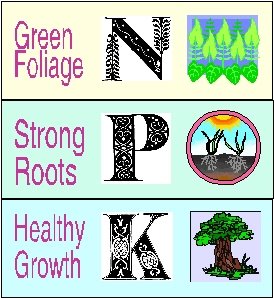What is fertilizer?
The broad definition of fertilizer is anything that is added to the soil, organic or inorganic, that increases the amount of nutrients in the soil. Organic fertilizer is any naturally occurring product, like decomposing leaves or animal matter. Inorganic fertilizers include any chemically produced fertilizers. Most bags of fertilizer include a mixture of organic and inorganic fertilizers. Not all plants or plants families require the same balance of nutrients, if you are growing orchids you should learn about orchid care, for peach trees- peach tree care etc. Read on for a basic introduction of fertilizers to get you started.
Why do plants need fertilizer?

Nitrogen produces green growth, Phosphorus is responsible for strong roots, and Potassium ensures healthy growth.
Plants require 16 elements that are essential to their growth and overall health and they fall into three categories.
Primary elements: Nitrogen, Phosphorus, and Potassium
Macronutrients: Magnesium, Calcium, Oxygen, Carbon, Hydrogen, and Sulfur
Micronutrients: Manganese, Iron, Copper, Zinc, Boron, Molybdenum, and Chlorine
The primary elements are used to perform basic plant functions and, along with macronutrients, are needed in large quantities. The micronutrients, or trace elements, are needed in smaller quantities, but are still important to plant health. Carbon, Oxygen, and Hydrogen can all be absorbed from the air and/or water but plants rely on the soil to provide the other needed elements. Because not all soil is the same, fertilizer is used to ensure that plants have all 16 essential nutrients. It encourages plant growth, enhances plant color and appearance, and is helpful in establishing new plants.
Fertilizer Basics:
- N-P-K: This label is on every fertilizer bag and it stands for Nitrogen-Phosphorus- Potassium. It will tell you the percentage of each element by weight in the bag. For instance, in a 16-4-8 bag of fertilizer there is 4 times more Nitrogen than Phosphorus and 2 times more Nitrogen than Potassium. In Florida, we tend to have plenty of Phosphorus in our soil so you typically want to go with a fertilizer that has less Phosphorus than Nitrogen or Potassium.
- Slow Release Fertilizers– These are typically more expensive but usually worth the added cost. In Florida, we have sandy soils, which is great for drainage but bad if you are trying to retain nutrients because when it rains, most of that fertilizer ends up in storm drains and lakes around town. This is detrimental to our water quality and wildlife. Slow release fertilizers are coated and release nutrients into the soil over longer periods of time than standard fertilizers, meaning you have to fertilize less often and less of it is wasted. Adding worm castings manure to the soil aerates and improves its overall structure while providing beneficial nutrients to plants.
- When not to fertilize: Do not fertilize before a plant flowers. Fertilizers encourage a plant to grow. If you fertilize a plant before it flowers, it will typically make more leaves and stems (green growth) instead of flowers. It is also not appropriate to fertilize plant leaves. Fertilizer should be administered in the soil. Do not fertilize in a drought or when a plant is not getting enough water. Finally, do not fertilize a plant in the winter or late fall. If a plant has a lot of new growth on it, it is much more susceptible to frost damage and/or death in the event of a frost.
If you have any questions or would like to schedule a free estimate, contact us or call our office at 407-935-9151.


0 Comments